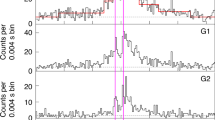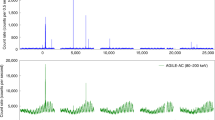Abstract
The binary system Cygnus X-3 is a source of high energy γ rays (>1015 eV)1,2, and the existence of quiescent radio emission from this system3 is suggestive of a strong magnetic field extending well beyond the binary orbit4. We show here that the high-energy γ rays traversing this field could be attenuated by magnetic pair production process, resulting in the rather sharp steepening of the γ-ray spectrum beyond about 1016 eV. Using the observed spectral steepening2, we derive a magnetic field strength of 0.7 G in the region ∼1014 cm, where most of the observed radio emission takes place. The observed light curve above 1015 eV shows only one significant narrow peak at a phase of about 0.2 from the X-ray minimum. This could result from the magnetic bending of the charged particles from the pulsar before interacting with the enshrouded matter. We predict that the relative contribution of steady flux should increase beyond 1016 eV.
This is a preview of subscription content, access via your institution
Access options
Subscribe to this journal
Receive 51 print issues and online access
$199.00 per year
only $3.90 per issue
Buy this article
- Purchase on Springer Link
- Instant access to full article PDF
Prices may be subject to local taxes which are calculated during checkout
Similar content being viewed by others
References
Samorski, M. & Stamm, W. Astrophys. J. Lett. 268, L17–21 (1983); Proc. 18th int. Cosmic Ray Conf., Bangalore 1, 135–138 (1983).
Lloyd-Evans, J. et al. Nature 305, 784–787 (1983).
Mason, K. O. et al. Astrophys. J., 207, 78–87 (1976).
Vestrand, W. T. Astrophys. J. 271, 304–314 (1983).
Davidsen, A. & Ostriker, J. P. Astrophys. J. 189, 331–338 (1974).
Hertz, P., Joss, P. C. & Rappaport, S. Astrophys. J. 224, 614–624 (1978).
Ghosh, P., Elsner, R. F., Weisskopf, M. C. & Sutherland, P. G. Astrophys. J. 251, 230–245 (1981).
Geldzahler, B. J., Kellermann, K. I. & Shaffer, D. B. Astr. J. 84, 186–188 (1979).
Tsytovich, V. N. A. Rev. Astr. Astrophys. 11, 363–386 (1973).
Morello, C., Navarra, G. & Vernetto, S. Proc. 18th int. Cosmic Ray Conf., Bangalore 1, 127–130 (1983).
Stepanian, A. A., Fomin, V. P., Neshpor, Yu. I., Vladimirsky, B. M. & Zyskin, Yu. L. Proc. int. Workshop on High Energy Gamma-Ray Astronomy, Ootacamund, India (eds Ramana Murthy, P. V. & Weekes, T. C. ) 43–63 (Tata Institute of Fundamental Research and Smithsonian Institution, Bombay, 1982).
Danaher, S., Fegan, D. J., Porter, N. A. & Weekes, T. C. Nature 289, 568–569 (1981).
Mukanov, J. B., Nesterova, N. M., Stepanian, A. A. & Fomin, V. P. Proc. 16th int. Cosmic Ray Conf., Kyoto 1, 143–146 (1979).
Dowthwaite, J. C. et al. Astr. Astrophys. 126, 1–6 (1983).
Helmken, H. F. & Weekes, T. C. Astrophys. J. 228, 531–535 (1979).
Hayashida, N. et al. Proc. 17th int. Cosmic Ray Conf., Paris, 9, 9–12 (1981).
Lamb, R. C., Godfrey, C. P., Wheaton, W. A. & Tumer, T. Nature 296, 543–544 (1982).
Gould, R. J. & Schreder, G. P. Astrophys. J. Lett. 274, L23–L25 (1983).
Erber, T. Rev. mod. Phys. 38, 626–659 (1966).
Gould, R. J. & Schreder, G. P. Phys. Rev. 155, 1404–1407 (1967).
Dickey, J. M. Astrophys. J. Lett. 273, L71–L73 (1983).
Eichler, D. & Vestrand, W. T. Nature 307, 613–614 (1984).
Vestrand, W. T. & Eichler, D. Astrophys. J. 261, 251–258 (1968).
Author information
Authors and Affiliations
Rights and permissions
About this article
Cite this article
Stephens, S., Verma, R. Magnetic pair production in Cygnus X-3 and a cut off in the γ-ray spectrum. Nature 308, 828–830 (1984). https://doi.org/10.1038/308828a0
Received:
Accepted:
Issue Date:
DOI: https://doi.org/10.1038/308828a0
This article is cited by
-
Origin of ultra-high-energy γ-rays from Cygnus X-3 and related sources
Nature (1986)
-
First observation of ultra-high-energy γ rays from LMC X-4
Nature (1985)
-
Is Cygnus X-3 a monoenergetic 1017 eV accelerator?
Nature (1984)
-
Clues from the photonuclear time scale on the nature of particle accelerators in Cygnus X-3 and Vela X-1
Nature (1984)
Comments
By submitting a comment you agree to abide by our Terms and Community Guidelines. If you find something abusive or that does not comply with our terms or guidelines please flag it as inappropriate.



